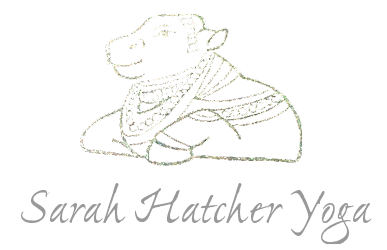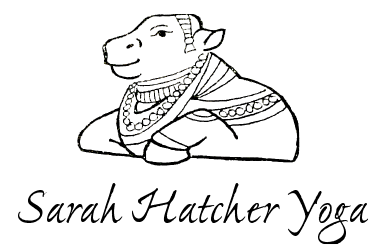Practicing with Discernment
When we first begin yoga, it is a tall order to learn how to do it safely. So many of the asanas (postures) are challenging and require physical and mental stability. Any seasoned student knows that in order to learn anything new or challenging - the first step is commitment: we have to get on the mat regularly.
There is a level of dedication that is also required in order to learn how to keep oneself safe, and this main key player for this to happen is discipline. The other key ingredient is finding a seasoned teacher who is in an environment where you feel comfortable enough to share with them how you feel and what is going on in your body and life. Where you practice with them is key - in a studio where it is practical for you to attend or online; for some people, individual sessions is the best way to find this relationship. Currently there is so much yoga out there, a little bit of shopping for the right teacher and for the right style of yoga that suits you is a good idea. And then when you have figured out which style works for you, stick with it.
I wish I could say it would be ok for a new yoga student to come once a week…but it just isn’t enough. A student needs at least two or three days a week on the mat with their teacher to understand what to do.
An example of this is that recently I have been seeing a physiotherapist for a groin injury - she says it is my gracilis. With a little needling, heat and exercises that she has prescribed, it is getting better along with my whole hip health in general. First thing she prescribed to me was:
”Do your exercises every day.”
I asked her,
”Is it like practicing? I have to do it every day or I won’t get the benefit of it?”
”Bingo.”
Like us yoga enthusiasts - in order to understand the postures and what we are learning, we understand we have to do it regularly or often in order to reap the benefit.
The key here though is not to blindly follow.
To blindly follow means that you get stuck in a rut of doing something the same way over and over that doesn’t serve you. It is difficult to discern what is good for you and what isn’t. Especially when you are at a new yoga studio, learning something new and figuring out the how-to’s, it is very difficult to know whether a posture may hurt you or not.
Plus you want to impress that teacher! It is likely that you are doing all you can to do the posture correctly and you want to do it right for yourself and for your teacher - you may even even over do it so that you can move on to the next posture or to be recognised for your effort.
You must use discernment in this process of learning yoga! If it hurts, stop, rest. If the practice causes so much discomfort and you lose track of your breath, then definitely stop. To continue practicing when there are visible signs that something doesn’t feel right or is physically painful is to blindly follow. This blind-following has some terrible repercussions.
Let’s look at why a student would get stuck in a yoga practice trap. They may find themselves in an unsafe place or even burn out of ashtanga yoga entirely due to injury or because they didn’t have the right mentor to guide them.
ॐ
A short history lesson of the modern ashtanga yoga practice teaches us that it wasn’t that long ago that teachers were so strict about yoga asana that they took postures away from students; “stopped” them at places where they thought they needed to understand what they are currently working on before moving on; and even gave super strong or even painful adjustments to students.
The ethos of placing a student into a posture has been the norm during an Ashtanga Yoga Mysore style class. The teacher would come over and adjust you, almost always. Sometimes, that teacher would take the student way beyond their comfortable place, past their edge in every posture in order to find the fullest potential in the pose.
The etiquette of Mysore style was that the teacher knew everything. That they could see what you needed to learn or put you in the posture that was right for you. This idolising a teacher to the point where they are placed upon a pedestal as if they were all-knowing was downright dangerous, and even a bit belligerent as yoga students found themselves in an unhealthy student/teacher relationships without really knowing how it happened.
I went to Mysore in 2008 to practice with the young Sharath Jois and the guru of the method, Sri K Pattabhi Jois. At the time Jois was nearing the end of his life; he passed away just a year later. He wasn’t adjusting much, mostly in and out of the Mysore room sitting in his chair but still very active in the room, you could feel his eyes everywhere. I had been to see him a few years earlier when he visited the Puck Place in New York City for his week intensives so I had a little experience with Guruji but not a lot.
I was catching my heels in Urdvha Dhanurasana right from day one. Now I was lucky, I had been practicing at that point almost eight years and had practiced it before with a teacher and knew the ins and outs of it. Plus I have a gymnastics and rock climbing background so backbending is a comfortable asana for my body. However the ones who weren’t really ready to be ‘catching’ were also catching. I remember seeing some people who weren’t really established backbenders being put into extreme backbends; something I’ll never forget that feeling of watching something that looked like a combination of magic and tragedy; how could they even get that person into a backbend? And why put them into that position in the first place?
This was the codified method for a very long while - put the student into the posture and with time they will get to understand it and learn how to do it on their own.
Now teachers are a little more sensible; partly due to the #metoo movement and to the misconduct of the late guru of the method, Sri K Pattabhi Jois, the ashtanga yoga practice - especially in the Mysore style - has changed. Some teachers don’t adjust at all. Some studios have cards where students can place on their mats to indicate without verbal discussion that they do or don’t want to be adjusted. Some teachers don’t teach at all anymore - they simply turned back in their authorisations…some teachers took a big break, and others like myself, have kept teaching with more sensibility.
Why? The allegations of Pattabhi Jois’ misconduct - in recent years many people shared how they were touched inappropriately while he was teaching them yoga. The ashtanga yoga global community reacted in different ways - some teachers renounced their authorisations, some took photos of Guruji down in their shalas, and some people stopped practicing ashtanga yoga altogether. A few teachers said nothing at all. If you read the blog posts by Guy Donahaye (click above link), you will be able to read multiple accounts of his misconduct and dive into the whole topic of what has happened and who has suffered.
Students and teachers who are still practicing with daily discipline fuelled by meditation, dedication and the breath - have taken a fine look at Pattabhi Jois’ behaviour and learned from it: how could they not?! For those of us who continue to teach and practice this method, we have had to look at the past and offer our sincerest condolences for those who have suffered, however we can only move forward and share this style in the most sincere and transparent way.
Students and teachers who are still practicing understand that nowhere in the method is it ok to harm another, touch them inappropriately or cause trauma. Many of us searched through every memory to find any place where we saw misconduct in a Mysore room and worked on our own reaction to it. Did we say something? Should we have?
The informed modern Ashtanga Yoga teacher has educated themselves on new ways of teaching; we have observed our own language, adjustments, our own trauma, and studied how we can be better teachers of yoga. We share this style of yoga in the most sincere and authentic way, offering modifications to the series, offering props or blocks where needed and adapting the series to suit the students’ needs. We seek to be more informed educators of yoga.
Some of us like myself, still have a huge place of love for Guruji and the Ashtanga Yoga method in their hearts; Guruji’s teachings and his contagious smile is a reminder that everyone - even the guru, suffers. For anyone reading this and hasn’t heard about this before I apologise for not writing about it sooner. It is more important than ever to share it. For teachers of the Ashtanga Yoga method, it is important to share the story of Ashtanga Yoga with your students - especially new students. Also, I apologise to anyone who has been physiologically, physically or mentally abused by myself, by any yoga teacher or guru, and by Pattabhi Jois.
ॐ
Blindly following - have you noticed something not right in your yoga practice or in the Mysore room? Did you stop and address it or were you so wrapped up in the moment you kept at it? Remember that when doing yoga, you can experience 1), liberation; or 2), an experience. Liberation happens when you can discern - look closely at the experience without attaching to it or wanting more of it. This will take some viveka - clear looking and observation - also a bit of svadhyaya - self study; study of the object of your meditation - your practice; and some faith. This faith could be in your teacher, faith in the practice you are doing and faith in the divine that supports you in your yogic endeavours.
Faith however - śraddha - doesn’t mean overlooking something that isn’t right. This is what I mean by practicing with discernment. Modifying your practice to make it suit your needs is practical practice; practicing with a teacher who believes in you and is open to discussion about topics such as the one in this post is key; and also, be confident in yourself to go ahead and change what needs to be changed in the method so it helps you find that joyful yogic space to shine.
ॐ
Come study with me online or here in Dublin at Little Bird Yoga and Coffee. Visit my teaching calendar for practice dates and times and let me know in the comments how your practice is bringing you closer to your truer self, your most kindred self, your most gracious self.
New to Ashtanga Yoga in the Mysore style? Join me for my monthly workshop at Little Bird Coffee and Yoga - 12 March fro 3-5 pm where we will discuss the philosophy of Patañjali’s Ashtanga Yoga and practical Ashtanga Yoga practice.


